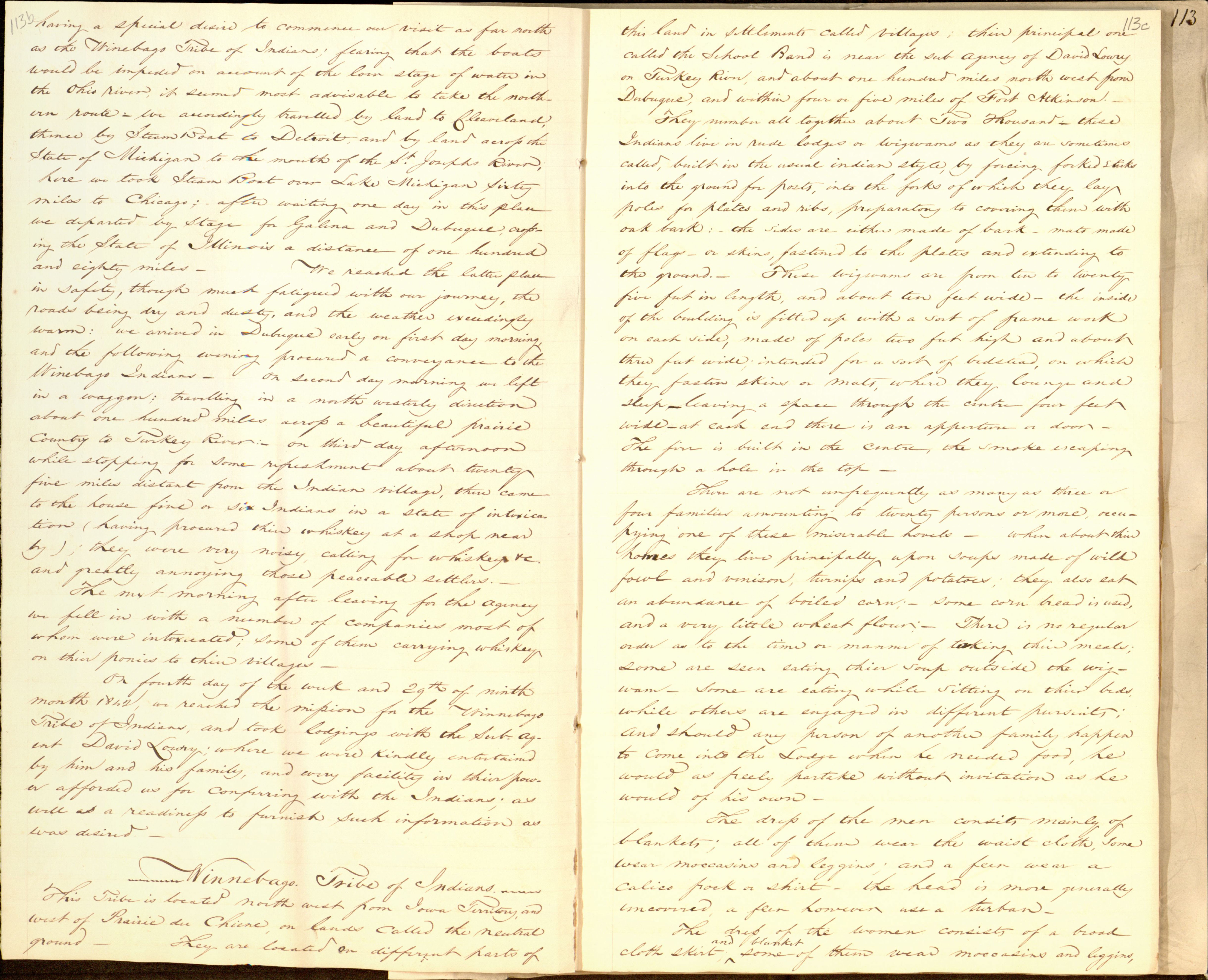having a special desire to commence our visit as far north
as the
Winebago Tribe
would be impeded on account of the low stage of water in
the Ohio river
ern route--for accordingly travelled by land to Cleaveland
thence by Steam Boat to Detroit
State of Michigan
here we took Steam Boat over Lake Michigan
miles to Chicago
we departed by Stage for Galina
ing the State of Illinois
and eighty miles. We reached the latter place
in safety, though much fatigued with our journey, the
roads being dry and dusty, and the weather exceedingly
warm: we arrived in Dubuque
and the following evening procured a conveyance to the
Winebago
in a waggon; travelling in a north westerly direction
about one hundred miles across a beautiful prairie
country to Turkey River
while stopping for some refreshment about twenty
five miles distant from the Indian villages, then came
to the house five or six Indians in a state of intoxica-
tion (having procured their whiskey at a shop near
by); they were very noisy, calling for whiskey &c.
and greatly annoying those peaceable settlers.
The next morning after leaving for the agency
we fell in with a number of
companies most of
whom were intoxicated; some of them carrying whiskey
on thier ponies to their villages.
On fourth day of the week and 29th of ninth
month
1842, we reached the mission for the Winnebego
Tribe of Indians, and took lodging with the Sub. Ag-
ent David Lowry
by him and his family, and every facility in their pow-
er afforeded us for conferring with the Indians; as
well as a readiness to furnish such information as
was desired.
This Tribe is located north west from Iowa Territory
west of Prairie du Cheine
ground. They are located on different parts of
this land in settlements called villages; thier principal one
called the School Band is near the sub Agency of David Lowry
on Turkey River
Dubuque
They number all together about Two Thousand--these
Indians live in rude
lodges or Wigwams as they are sometimes
called, built in the usual indian
style, by forcing forked sticks
into the ground for posts, into the forks
of which they lay
poles for plates and ribs, preparatory to covering them
with
oak bark: the sides are either made of bark--mats made
of
flags--or skins, fastened to the plates and extending to
the ground. These
wigwams are from ten to twenty
five feet in length, and about ten feet
wide--the inside
of the building is fitted up with a sort of frame work
on each side, made of poles two feet high and about
three feet wide;
intended for a sort of bedstead, on which
they fasten skins or mats, where
they lounge and
sleep--leaving a space through the centre--four feet
wide--at cash and there is an apperture or door.
The fire is built in
the centre, the smoke escaping
through a hole in the top.
There are not unfrequently as many as three or
four families amounting to
twenty persons or more, occu-
pying one of these miserable hovels--when
about their
homes they live principally upon soups made of wild
fowl
and venison, turnips and potatoes: they also eat
an abundance of boiled
corn;--some corn bread is used,
and a very little wheat flour;--There is no
regular
order as to the time or manner of taking their meals;
some are
seen eating their soup outside the wig-
wam. Some are eating while sitting
on thier beds,
while others are engaged in different pursuits:
and
should any person of another family happen
to come into the lodge when he
neede food, he
would freely partake without invitation as he
would of
his own.
The dress of the men consits mainly of
blankets; all of them wear the waist
cloth, some
wear moccasins and leggings; and a few wear a
calico frock
or skirt--the head is more generally
uncovered, a few however use a
turban.
The dress of the women consists of a broad
cloth skirt and blanket--some of
them wear moccasins and leggings,

